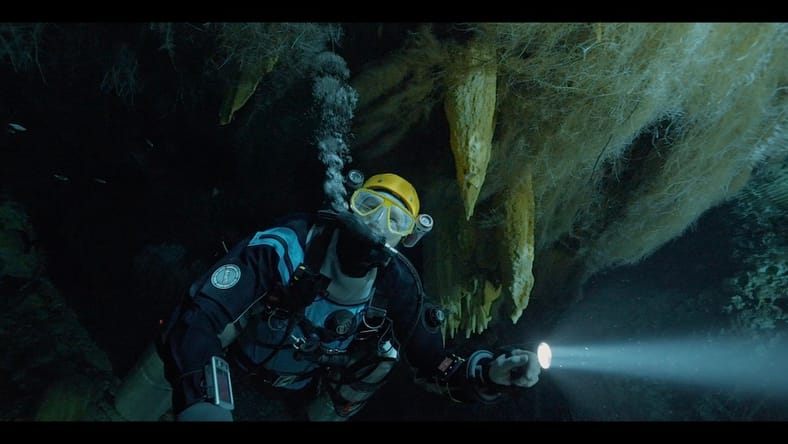
Diving Into The Darkness was filmed in locations you’re unlikely to see in any other film — or anywhere on Earth: It follows Jill Heinerth, who travels deep into the planet through cave diving.
The film, which premieres today at the Santa Barbara International Film Festival, includes jaw-dropping footage that Australian director Nays Baghai and his team recorded — mostly with Sony A7SIII — by following Heinerth on her expeditions around the globe, including an especially dangerous one in Mexico’s Sierra Mazateca mountains, in which they traversed an underwater passage deep below our planet’s surface.
The film doesn’t yet have distribution, but cries out to be seen — and negotiations are ongoing.
“I jokingly remind myself that if I can survive having to squeeze underwater through a two-foot-tall passage half a mile away from the surface, then surely I can withstand the various stressors and uncertainties that come with the securing distribution,” says Baghai.
We asked him a few questions over email about meeting Heinerth, shooting underwater, and reasons to dive into the Earth.
Nays Baghai on Diving Into Darkness With Jill Heinerth
MovieMaker: How did you first learn of Jill Heinerth and connect with her? Was she at all ambivalent about being the subject of Diving Into the Darkness?
Nays Baghai: I first met Jill in 2017 when I attended Australia’s largest dive conference, OzTek, for the first time. I was a film school student and a keen scuba diver, but I didn’t know a single soul in the dive industry at the time. As fate would have it, one of the first people I met was Jill, but it wasn’t until after I saw her presentation on a cave diving expedition to Cuba that I realized just how eminent and accomplished she was. Moreover, Jill is such a warm, generous person that we ended up talking for half an hour after the show and began a close friendship that would last many years.
Meeting all the incredible technical divers at OzTek made me curious to understand the motivations and psychology behind their breathtaking risks and challenges and how I could explore that question as a filmmaker. I was initially leaning towards a Chef’s Table– style documentary series centered on the psychology of the world’s best divers. But by the end of 2021, I decided to pivot towards a standalone documentary feature film instead, focusing solely on Jill’s story, especially having just read her autobiography, Into The Planet. At that point, Jill and I knew each other well enough that when I asked her if she was keen to adapt her life story into a feature film with me, her response was an immediate yes.
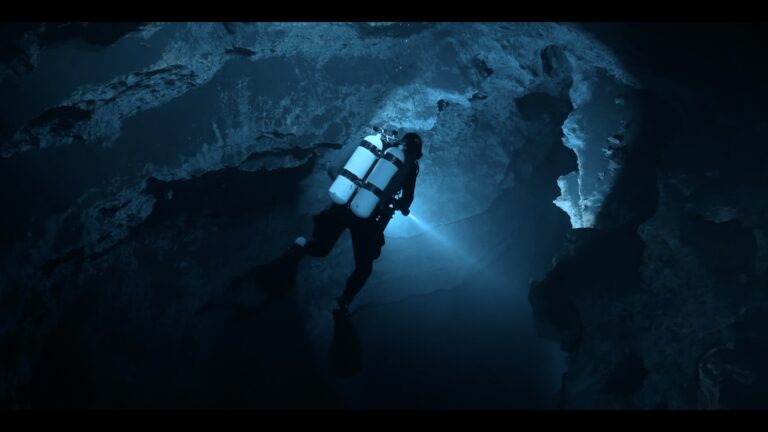
I believe her enthusiasm stemmed from not only the fact I wanted to tell a more authentic, character-driven story compared to what previous film crews had done, but also because I was a certified rebreather diver and knew the theory and practical side of diving more fluently than most directors. For me, it was an incredibly thrilling opportunity to be a translator between these two worlds.
MovieMaker: What’s your background in undersea filmmaking, and your film background in general?
Nays Baghai: The dual passions of film and diving were catalyzed in tandem when I saw Star Wars and The Blue Planet at age 6. However, what had a seismic impact on me was watching the behind-the-scenes documentaries for both of them; that was when I immediately knew I wanted to be a hybrid undersea filmmaker. However, it ended up being a full 12 years before that dream actually came to fruition. As a high school student, I spent my free time experimenting with various genres of film (drama, stop-motion, thriller, action, sci-fi, travel etc.).
Also Read: Cillian Murphy Copied Oppenheimer Down to His Nicotine-Stained Fingers
I also became a full-on cinema addict devouring everything I could get my hands on, from the artsiest Criterion Collection films to blockbuster classics. By the time I got accepted into AFTRS — the Australian Film Television & Radio School — I had seen close to 1,000 films and had won several awards in national film competitions in Australia and Canada.
During my first year at AFTRS I finally managed to make the underwater dream come true, when I volunteered as the underwater cinematographer for a classmate’s short film. The minute my finger clicked the shutter of the GoPro, I felt a much bigger click reverberate in my mind and soul. I knew this was where my passion and future intersected. But I also knew I had to accelerate my diving education quickly, as my entry level PADI Open Water diving certification would be insufficient to realize this dream.
I recalibrated the remaining two years at AFTRS so that I could curate a learning experience (both within and outside my university degree) to develop the skills I needed to be an underwater creative. At the time, there were no underwater cinematography courses, so I had to scour dozens of different sources to build up as much knowledge as I possibly could. If I didn’t have any assignments to take care of, I spent all my free time scuba diving and freediving in various environments — shark diving hotspots, wrecks, caverns, and under various conditions to build up my experience and comfort with the technical aspects of diving so that I could also safely film at the same time.
By the time I graduated from AFTRS, I also walked away with the highest-ranking recreational certifications in scuba diving and freediving, along with an introductory certification in rebreather diving.
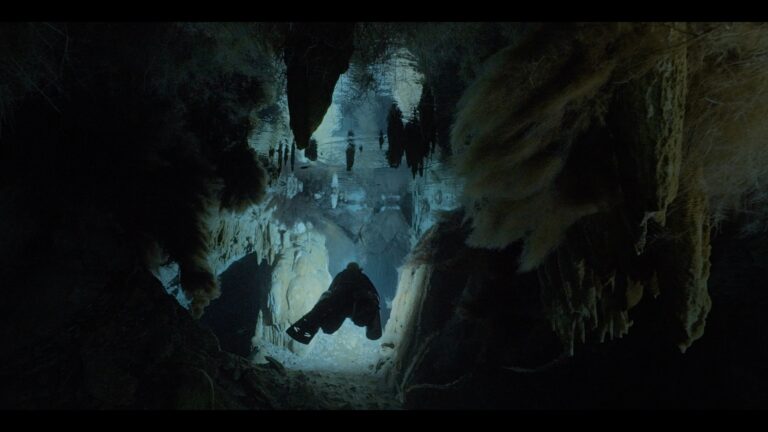
Diving with Jill Heinerth
MovieMaker: The opening of the film especially is just gorgeous and it seems like you must have taken all the risks that Jill did to film her in underwater caves – how did you do it? How many people on your team actually did cave-diving while shooting the film? What was the process like?
Nays Baghai: It took a lot to pull it off. For starters, although I was an experienced diver with nearly 200 logged dives, I had almost no cave diving experience, so before the shoot in Mexico, I enrolled in a cave diving course in Mount Gambier, South Australia. All certified cave divers have to pass what’s called the Stress Test.
This test occurs when you least expect it: your mask is ripped off, you’re removed from the guideline, your buddy is out of air, and your equipment isn’t functioning – all whilst in total darkness and, in my case, 50°F water. It’s designed to see how calmly students can problem-solve when things are going horribly wrong. I quickly learned that being a good cave diver means being an even-tempered, zen-like Jedi that doesn’t leave things to chance, and thoroughly assesses and prepares for all the possible risks in advance.
It really is the polar opposite of how cave diving is often portrayed in mainstream media as an adrenaline-fuelled daredevil sport. After that course, I became even more determined to change that stereotype with this film.
In Mexico, we typically had six people in the water — Jill, two cameramen, two safety divers, and me. Jill would be at the very front, while the two cameras were positioned in the middle to film her, and myself and the two safeties would be at the back to observe the whole thing. For the smaller caves that were too tight or too silty, we slimmed the crew down to Jill, one camera, and two safeties.
What was interesting about this shoot is that everyone on the crew was a highly experienced cave and technical diver, first and foremost, long before they forayed into filmmaking. It was the opposite of almost every other shoot I had worked on previously, and this high degree of diving fluency afforded us more time to focus on the creativity and execution of the scenes.
However, because this was the first time we had all worked and dived together, it took us a fair bit of time to get in the right rhythm. Even though I had prepared a 100-page encyclopedia with extensive plans before filming began, we ended up having to start from scratch because of how this specific project required a high degree of flexibility, and also, how unpredictable filming underwater is in general.
Eventually, we all settled into a routine at the dive shop every morning, where together, we would dissect the scene we were filming each day. As the director, I would start the meeting by writing out my shot list and explaining what I had in mind creatively and tonally.
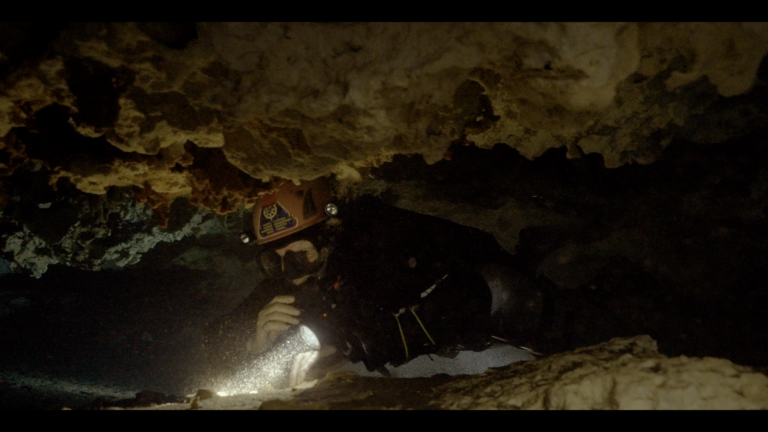
Janne Suhonen, the lead cinematographer, would then interpret my shot list by drawing out storyboards with accompanying diagrams that indicated where he wanted to position the cameras and lights. While discussing the scene, we would confer with Jill for historical accuracy and to Vincent Rouquette Cathala, our chief of safety, for the conditions and details of the cave we’d be filming in. This process usually took us an average of 45 minutes to do every morning, and once our rebreathers were ready, we then headed off to the cave and shot until we were exhausted.
MovieMaker: How much of the diving footage in the film did you and your team capture? Another way of asking this is, did you get any archival footage from Jill? For the Mexico dive, for example, in the Sierra Mazateca mountains? Did you do any recreations of her early dives?
Nays Baghai: The only two expeditions that exclusively used archival footage were Wakulla, in 1998, and Antarctica, in 2001. Jill also generously granted us unlimited access to her personal library of archival underwater footage & photographs, which we utilized as B-roll and inserts throughout the film.
The rest of the big expeditions had to all be reenacted simply because there was no footage that chronicled any of them. However, the absence of archival or stock footage ended up being a blessing in disguise — it meant we could shoot these scenes in a more cinematic, emotive way that made you feel what Jill experienced on each dive.
While we were filming in the various caves of Sistema Dos Ojos, it turned out we were diving in the exact same spots Jill herself had explored and mapped 25 years ago, which lent a strong sense of realism to the scenes.
To get inspired, I watched Touching The Void a few times both before and during filming because of how masterfully the filmmakers recreated the story in a very cinematic style that defied the cliches associated with documentaries. We all were united in our desire to make a compelling film that felt alive and more like Inception or Blade Runner rather than a run-of-the-mill anthropological documentary.
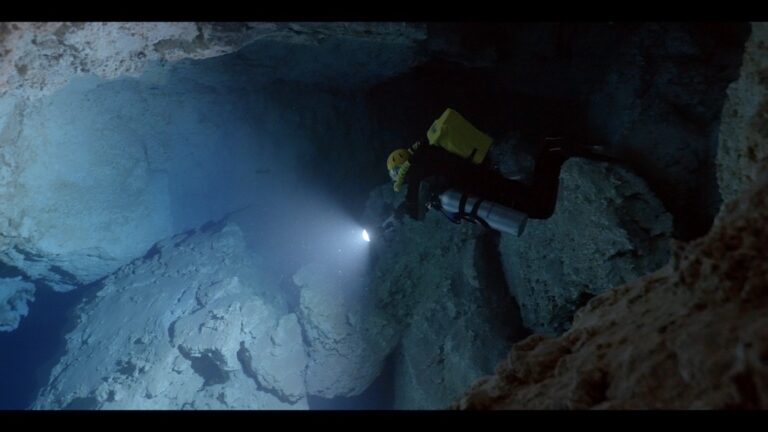
Why Jill Heinerth Cave Dives
MovieMaker: I was surprised to learn this isn’t just about thrill seeking – there’s a scientific need for her dives. Can you talk about what it is?
Nays Baghai: Jill says it best in the film – these caves are natural history museums that contain a variety of information that informs our past, present and future. This also feeds into the astronaut allegory of the film, given how it’s really science, not sport, that fuels cave diving.
One of the subplots we reluctantly cut from the film was the significance of the orange bacteria samples Jill and Ruth — the panicked diver — collected, as recreated in the film. For a long time, scientists have been studying various life forms — from bacteria to blind crustaceans — to figure out how they are able to live in total darkness without the aid of photosynthesis. It turns out the conditions that these organisms thrive in are not dissimilar to outer space, so it is important research as we explore other planets and consider how life can be sustained in hostile environments.
On the outer space note, my personal favorite scientific theme in the film is how Jill’s expeditions with Bill Stone were ultimately proving grounds for various technologies for outer space. The drysuits and rebreathers we use are very comparable to what astronauts wear when they’re doing spacewalks, and the 3D mapping technology Bill pioneered has now evolved to being done by autonomous robots.
In the Wakulla expedition, a deleted scene revealed that the data Jill and Bill extracted from the 20 miles of tunnels also helped advance conservation efforts and dialogues with politicians. By showing how this massive underwater river was right underneath an entire town, it proved just how vital these freshwater caves are for the residents and industries in any given region.
MovieMaker: What was your biggest challenge in making the film and how did you overcome it?
Nays Baghai: It would be easy to nominate the whole shoot in Mexico as the most difficult challenge of the whole production. The hurdles were endless — complex shot lists, grueling dive plans, rebreather issues, negotiating location permits, heat, mosquitoes, you name it.
However, for me personally, editing the whole film was actually the most colossal challenge of all. The post-production schedule for this film was a whopping 15 months, largely due to the fact the structure and storytelling were so complex and required many drafts and cuts before we finally nailed it. Some of the feedback in early screenings was particularly brutal, but it definitely helped evolve the story structure and film into a much better product.
There were far more moving parts to juggle, compared to my first film, Descent. I had to manage animation in Oslo, visual effects and music in Sydney, sound mixing and feedback in Los Angeles, plus technical support in Brisbane.
All told, I had nearly 70TB of footage and post-production assets to edit into a 96-minute film, which definitely pushed my computer to its limits. If you’re a director who also edits, the best tool you can have in your arsenal is having a very open mind, and the willingness to try new things while also being very deliberate and methodical. In a strange way, my personality as a cave diver lent itself well to the editing process.
While I am very proud of what I accomplished as an editor, I will be the first to admit that it took a very large toll on me. I owe a lot to my friends and family for being there for me when I was at my lowest and tempted to give up. The scene where Jill suffers from burnout and claustrophobia in her office was influenced by my own experience as much as it was by hers 30 years ago.
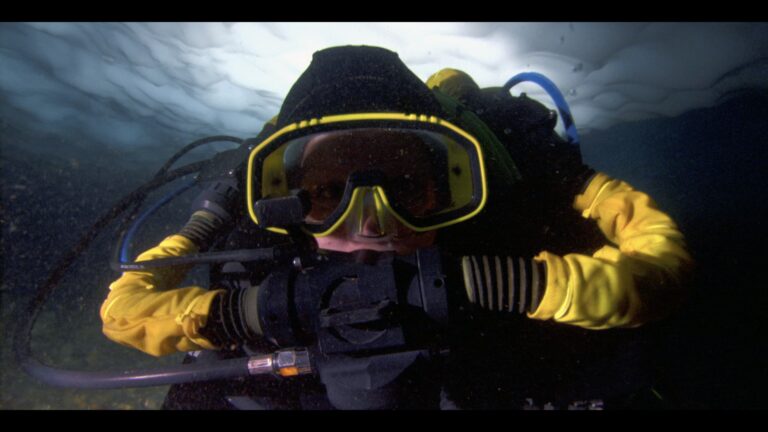
Despite all these challenges, I feel like I have learned many new skills and have much more confidence as a writer/director/editor. I also want to emphasize how grateful I am to the encouragement and guidance from the community of friends, family and professionals I had on this journey.
Nays Baghai on How His Team Shot Diving Into the Darkness
TM: What equipment did you use, especially underwater?
Nays Baghai: The whole film was shot on a menagerie of cameras from Arri, RED, Blackmagic and Sony. However, we ended up shooting the bulk of the underwater footage on the Sony A7SIII, mainly due to its lowlight capabilities, lightweight, compact body, reliability and battery life.
This especially became clear when we were in the total darkness of caves 25 minutes from the surface and needed a flawlessly performing camera to do the job under such tough conditions. We had a total of three A7SIIIs – two inside Nauticam underwater housings and another on the surface for topside filming.
However, none of the shoots would have been remotely possible without the help of our closed-circuit rebreathers. Because rebreathers recycle your breathing gas, that meant we could stay underwater for up to four hours, which was also a huge advantage from a safety perspective; the risk of running out of air was dramatically reduced. Another big advantage our rebreathers afforded was the absence of bubbles hitting the ceiling and reducing visibility.
Diving Into the Darkness premiered today at the Santa Barbara International Film Festival, and an encore screening will be held Wednesday, February 14. Screening details are here.
Main image: Jill Heinerth in Diving Into the Darkness, a film by Nays Baghai. Courtesy of Running Cloud Productions.
